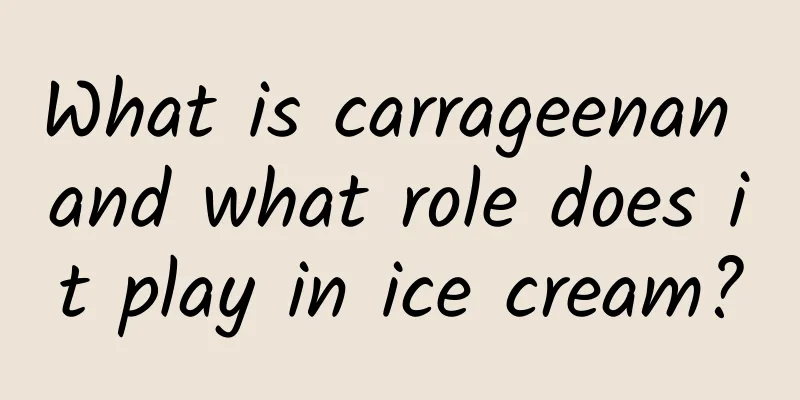What is carrageenan and what role does it play in ice cream?

|
Recently, "ice cream assassin" has become a hot topic. However, one wave of rumors has not yet subsided, and another wave of rumors has arisen. A netizen posted that a brand of sea salt-flavored ice cream under a certain brand has not completely melted after being left at room temperature of 31 degrees Celsius for nearly an hour. For a time, the news that ice cream will not melt has once again become a hot topic. Why doesn't the ice cream melt? The customer service said "a small amount of carrageenan is added". So what is carrageenan and does it have any side effects? Let's talk about it today! 01. Why doesn’t the ice cream melt? With a rigorous attitude, I looked at the ingredient list of the ice cream and found that the carrageenan mentioned in the question was indeed on the ingredient list. The second to last item is a compound emulsifying thickener, which specifically includes mono- and di-glycerol fatty acid esters, sodium alginate, locust bean gum, carrageenan, and guar gum. Among them, the three ingredients that can achieve the "non-dissolving" effect mentioned in the title are mainly locust bean gum, carrageenan and guar gum. According to the nominal rules of the ingredient list, the second to last item can indeed be considered a "small amount", and the specific three items should be locust bean gum>carrageenan>guar gum. 02. Three polysaccharides As mentioned above, the factors that prevent ice cream from melting are: three types of polysaccharides. Locust bean gum is also a thickener. Locust bean gum is a plant galactomannan extracted from the endosperm of carob seeds. Its structure is as follows: Locust bean gum itself can slow down and reduce the size of ice crystals, so it is often used in ice cream and other additives. Many people know that carrageenan is a hydrophilic colloid, a water-soluble polymerized galactose sulfate, which can be extracted from red algae seaweeds such as Eucheuma, Gelidium, and Staghornia, and can be used for solidification. Its structure is as follows Guar gum is also known as guar bean gum. As the name suggests, it is an extract of the leguminous plant guar bean. It is a galactomannan and is generally used as a food thickener. It can be seen that all three are polysaccharides. Polysaccharides can dissolve in water and form viscous, gel-like macromolecules after sufficient hydration. Therefore, they can play the role of thickening, stabilization and gelling. They can make food more viscous and have gel properties. Therefore, they are often used as food additives. Of course, in addition to this, some polysaccharides such as water-soluble dietary fiber also have some health benefits, and many probiotic foods contain similar ingredients. Specifically, the three polysaccharides in the ice cream can be divided into two categories: 1. Plant polysaccharides: locust bean gum, guar gum 2. Seaweed polysaccharides: carrageenan These three can not only play a role independently, but also cross-link with each other to form a good gel synergistic effect, which is a process of 1+1>2. For example, the picture below shows that locust bean gum and carrageenan form a good gel synergistic effect. 03. Are these three harmful to the human body? I believe that many people are surprised and curious when they see these additives, but what they are most concerned about is: Are these three harmful to the human body? As a golden saying goes, "It is foolish to talk about toxicity without considering the dosage." In fact, this sentence is applicable to all food additives. Currently approved food additives meet health standards within a reasonable range of addition. In fact, since these three polysaccharide gums have thickening effects, they are widely used in the food industry. For example, locust bean gum is a viscous soluble fiber, so it is often used as a dietary fiber supplement in the diet. The same is true for carrageenan, which is often added to food to supplement dietary fiber and can even be used to make capsule shells. So, in theory, it meets the health standards. In fact, many ice creams and jellies also contain these ingredients. 04. Is it legal to add these ingredients to ice cream? The standard for ice cream is GB/T 31119-2014 Frozen Beverage Ice Cream This standard is also very inspiring. Let's first look at the national standard. Ice cream is generally divided into the following categories: On this basis, it belongs to raw and auxiliary materials. In the standard, raw and auxiliary materials can be divided into the following categories: 5. Raw and auxiliary materials 5.1 Drinking water should comply with the requirements of GB5749. 5.2 White sugar should comply with the requirements of GB317. 5.3 Dairy products should comply with the relevant national standards or industry standards for dairy products. 5.4 Egg products should comply with the requirements of GB2749. 5.5 Edible vegetable oils should comply with the requirements of GB2716. 5.6 The quality of food additives and food nutrient fortifiers should comply with the relevant national standards or industry standards. 5.7 Other raw and auxiliary materials should comply with the relevant national standards or industry standards. For example, the common white sugar that makes ice cream sweet is an added ingredient allowed by national standards. Locust bean gum, carrageenan and guar gum fall under 5.6 food additives and food nutrient enhancers specified in the national standard. Therefore, overall, I personally believe that these added ingredients are in compliance with regulations and do not pose a health threat. 05. Do you want to eat ice cream or something “delicious”? So why did it cause such an uproar? This is actually a question I have always wanted to talk about: In fact, this question is very interesting. In many cases, the so-called deliciousness we pursue is the question of "how to make the best combination of additives". If a packaged product makes you feel extremely delicious, then please take a closer look at the ingredient list, which is often the process of better adjusting the additives. However, this is also inevitable in the modern food industry. After all, it is extremely difficult to improve raw materials, and objective materials will also determine their basic taste. So, how to make food more delicious has become an important part of the food industry, and diversified food additives have naturally become the preferred choice. But overall, I still advocate rational consumption. Finally, let me reiterate: I personally have no objection to food additives, and the reasonable use of food additives does not pose a health threat. [1] Du Xunan. Synergistic mechanism and application of κ-carrageenan/locust bean gum mixed gel[D]. Hubei University of Technology, 2020. DOI: 10.27131/d.cnki.ghugc.2020.001104. |
>>: In summer, you must deworm your cats and dogs! But how to use toxic deworming medicine?
Recommend
The home appliance market once again ushered in a new turning point in the business war
Everything will be reset to zero. With the openin...
iOS 10 Beta 3 released: lots of bug fixes
Early this morning, Apple pushed the iOS 10 Beta 3...
Powerful core, surging power - Tsinghua Tongfang A8500 commercial computer review
Speaking of the domestic brand Tsinghua Tongfang,...
Only by deceiving the fat can you truly lose weight!
Fat is the most hated tissue in the body (no doub...
How to quickly and effectively increase the number of APP users?
In recent years, more and more people have entered...
Let's go to the Red Planet. A live streaming sales course (online) that is closer to the truth, helping you run live streaming sales 0-1
Let's go to the Red Planet, a live streaming ...
Tik Tok operation skills in the catering industry!
1. Current market situation of catering industry ...
"In-depth Unveiling of the Algorithmic Rules for Popularity on Douyin Short Videos" will help you take a step forward in the shortcut of Douyin operation and monetization
"In-depth Unveiling of the Algorithmic Rules...
They are most afraid of you going to the hospital...
“As long as you can hold it in, there is no need ...
Is autonomous driving equivalent to a frog driving a car? How far do smart cars have to go?
Self-driving cars are already a hot topic that ev...
A detailed explanation of shared power banks (with operation strategies)
The author of this article conducted a market ana...
How can a new anchor quickly get started with live streaming and selling products? (Contains a guide to avoiding pitfalls)
1. Getting started as an anchor How to quickly tr...
International Acromegaly Awareness Day | Do people become "uglier" as they age? Swollen hands and feet, high blood pressure may be the reason...
As people age, they may notice that their cheekbo...
Shenchen Panda Compass: Top Ten Marketing Methodologies (11 sections)
Shenchen Panda Compass: Top Ten Marketing Methodo...









